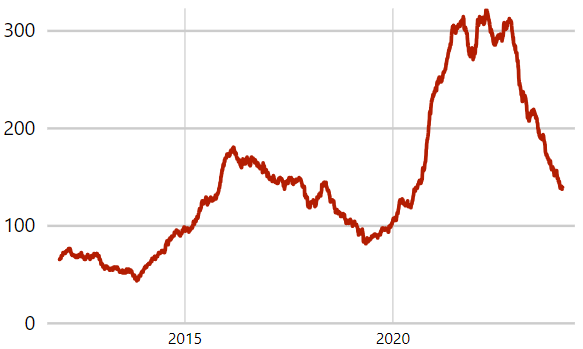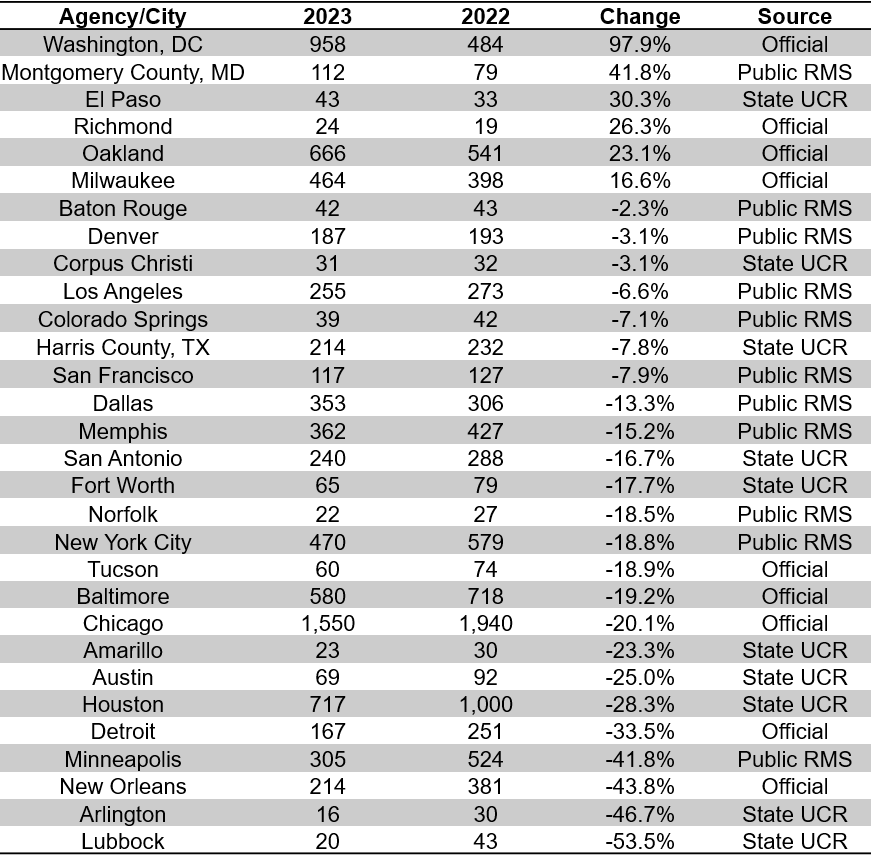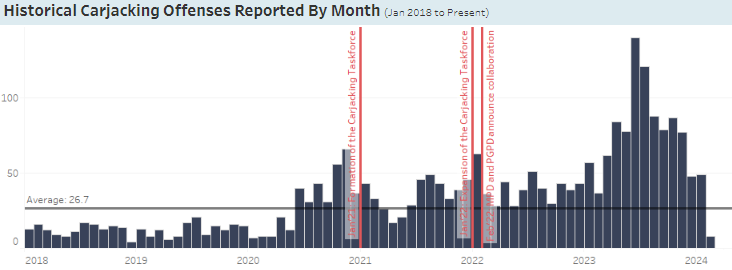Carjackings Fell In 2023 In Most Cities With Available Data
It's hard to say what it means for a national trend though.
Carjackings are a weird crime to try and tease out a trend for1. The FBI did not begin reporting national carjacking estimates until 2022 after the switch to NIBRS. BJS, by contrast, has been collecting survey data on carjackings since at least the 1980s. That means that analyzing carjacking data is a bit of traditional analysis with a bit of trying to evaluate the holes in crime data.
The FBI’s Uniform Crime Report defines carjacking as “a robbery offense where the property stolen is identified as a vehicle” while BJS defines it similarly as a type of robbery which involves the “theft or attempted theft of a motor vehicle by force or threat of force.”
The FBI’s report on 2022 crime trends states that carjackings within NIBRS-compliant agencies rose 8.1 percent from 2021 levels. This increase comes on the heels of BJS reporting carjacking levels that were near the lowest levels it has recorded in 2021. So carjacking levels are generally low but appear to have risen over the last few years.
This is backed up by data from the Council on Criminal Justice showing carjackings rising considerably since 2019, but they only had 10 cities of data and one of them is DC which had an outsized increase in 2023 that is bound to skew any sample at this point. It’s also hard to compare data from 2019 to 2023 for a lot of cities because some cities that were not NIBRS compliant in 2019 may not have fully tracked carjackings that year — if at all (San Antonio and Harris County in Texas reported 1 combined carjacking in 2019). That said, there are plenty of agencies that have had a consistent definition of carjackings since before 2019, and many of those agencies saw big surges in those crimes between 2019 and 2022 (see New Orleans below).
But what about the trend in 2023?
Unlike murders, carjackings are tough to track using city data because most cities do not publish data on these incidents. Usually they get rolled up into other types of robbery.
A handful of cities, however, do publish aggregated information on carjackings and a few more specify carjacking incidents in their publicly available Record Management Systems.
This smorgasbord of crime data allows us to make some guesses as to the carjacking trend in mostly big US cities though it’s far less clear that this collection of data reflects a larger overall national trend compared to our data collection on murder.
I managed to get 30 cities of data comparing carjacking figures for 2022 to 2023. 9 of the 24 cities had official aggregated carjacking statistics on a publicly available website (here’s Milwaukee’s for instance). There were 11 other agencies that have publicly available crime data through their Record Management System or Computer-Aided Dispatch with carjacking as one of the offense types. This is less precise that the official numbers produced by an agency, but should hold decently close to that agency’s trend.
The other 10 agencies I took from the Texas state UCR program’s excellent crime data website. This is important to note because I had to use the advanced search on the website to identify carjackings by the FBI’s definition. I searched for all robbery incidents where an automobile was the property stolen. This should match the FBI’s methodology in calculating carjackings, but I never have full confidence in DIY crime data and there’s no way to say for sure (I also only used a property loss code of “Stolen”, if you include “Recovered” you get substantially more incidents though the trend remains the same). All of these agencies were NIBRS compliant in 2022, so there’s no issue in comparing 2022 and 2023 at least. Of note, I only analyzed the Texas agencies with 30+ carjackings in 2022.
The results from the 30 agencies is below. Carjackings fells from 2022 to 2023 in 24 of the 30 agencies with Washington, DC standing as the outlier *again* with by far the largest increase. The agency with the second biggest increase from 2022 to 2023 is Montgomery County, Maryland which is right next to DC and at least suggests there’s some commonalities in the DMV area (though nearby Baltimore experienced a decline). Almost all of the Texas cities saw a decline though I’m somewhat worried that I calculated the search wrong or the results are biased for some other strange reason related to having to put together the query myself.
The good news for DC — well, maybe not good news, but at least it’s less bad news — is that carjackings appear to be falling there as well though it’s way too early in the year to say anything definitive. DC maintains an excellent website for tracking carjackings which shows a possible slowdown in carjackings in December and January. These incidents are still occurring at a high rate there though with some producing tragic results such as the murder of Mike Gill in late January.
All told, this is decent evidence that carjackings fell last year, but the sample size is not overly large and the data collection mechanism raises some questions. If this was data for another, more established crime — like murder — I’d say it’s pretty strong evidence of a national decline being likely though with a healthy margin of error as to the size of the decline.
But carjackings are somewhat tough to define, most agencies do not publish formal statistics on carjackings, and I had to use various sources of data to compile the above table of 30 cities. It’s safe to say that carjackings fell from 2022 to 2023 in these cities, though incidents remained more common many places compared to pre-COVID in some of them. The above data weaknesses, however, mean that there remains some uncertainty to the assessment that carjackings fell more broadly in 2023.
I’m leaving this clunky sentence because it reminds of of the Winston Churchill quote “This is the type of arrant pedantry up with which I will not put.”






For the past several years I have had issues with any crime data reporting. With the trend of down-sizing the Police departments if data is reported it is probable skewed to keep the "elected officials" from looking bad. Even the politicization of the FBI has tainted anything they report, in my eyes...
Hi Jeff: Excellent report. But is BJS tracking carjackings yearly? There are a number of specialized BJS publications that are one-shot overviews of crime issues or are explorations of issues (i.e., localized crime data). To my knowledge, there is nothing about carjackings in recent-yearly BJS reports. Thanks, Len.